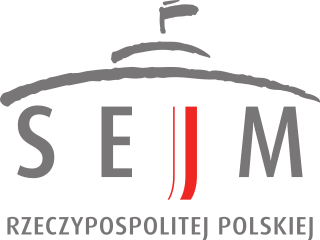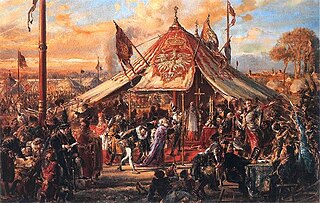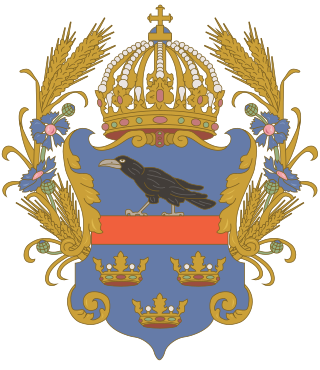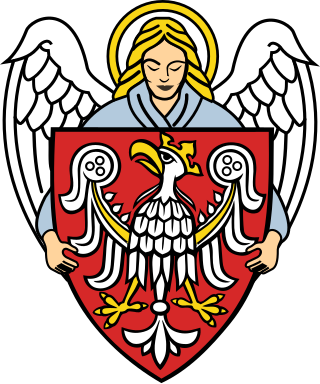History
The traditions of a sejmik can be traced to the institution of the wiec that actually predates the Polish state. [3] They originated from gatherings of nobility, formed for military and consultative purposes. [2] [4] Historians disagree about the specific date of origin of the sejmiks, with some proposed dates being 1374 (the Privilege of Koszyce) and 1454 (the Nieszawa Statutes). [5] Geographically, sejmiks first arose in central Poland (Greater Poland province). [5] Over the next century or so, they spread to other provinces of Poland, and finally, by the 16th century, to the Grand Duchy of Lithuania. [6] Sejmiks were legally recognized by the 1454 Nieszawa Statutes, in a privilege granted to the szlachta (Polish nobility) by King Casimir IV Jagiellon, when the king agreed to consult with the nobility concerning certain decisions. [1] [2] [7] Casimir's recognition of the sejmik stemmed from an attempt to limit the growing power of the magnates, and counteract it with the middle nobility. [8]
With the creation of a national Sejm in 1493, which took over the powers of taxation and the pospolite ruszenie previously granted to sejmiks at Nieszawa, the importance of regional governance somewhat diminished. [4] [8] Still, the sejmikis continued to play an important role in the governance of Poland as the most direct form of political enfranchisement of the nobility. [8] [9]
In the 1560s, the state organization of the Grand Duchy of Lithuania was reformed in accordance with the Polish model. [10] An act of July 1564 established sejmiks in the Grand Duchy. [11]
After the Union of Lublin in 1569, the Polish–Lithuanian Commonwealth had about 70 sejmiks (out of those, 24 were in the Grand Duchy of Lithuania). [8] Jacek Jędruch notes a trend of an increasing number of sejmiks over time, from about 16 in the 15th century to 104 by the late 18th century, as nobility sought to meet in places that required less travel time. [12] Stanisław Płaza also estimates about 100 at the turn of the 18th century. [13] Those sejmiks elected 170 deputies (48 from Lithuania). [8] Most sejmiks elected 2 deputies, but there were exceptions. [nb 1] [14] Wojciech Kriegseisen notes that until the late 18th century, there were 44 sejmiks in Poland proper (the Crown of the Kingdom of Poland), 24 in Lithuania, and 1 in Inflanty province. [15]
The sejmik's role grew again in the late 17th century, as central power weakened. [4] [16] Sejmiks attained the peak of their importance at the turn of the 18th century, when they often set their own time limits—that is, they extended their authorized periods of operation. [16] In the face of an inefficient central government, with the national Sejm often disrupted by the liberum veto and the office of starosta losing much of its importance, sejmiks administered a portion of the taxes, and raised their own military (wojsko powiatowe). [16] This period, which was known as the "rule of sejmiks" (rządy sejmikowe), was brought to an end by acts of the one-day Silent Sejm (Polish: sejm niemy) of 1717, which removed most taxation and military competences from the sejmiks. [16] Some sejmiks were also affected by liberum veto until it was abolished for sejmiks in 1766; [17] this was not always the case, as some decided to forgo unanimity and move to majority rule. [16]
Where the middle nobility had been the leading force at the sejmiks in the 16th century, the magnates became increasingly influential in the 18th century. [4] [16] This stemmed from their ability to bribe masses of poorly educated, landless nobility (known as magnate's "clients" or "clientele"), as all nobles were eligible to vote in the sejmiks. [16] [18] [19] [20] [21] Sejmiks in Lithuania were dominated by the magnates to a greater extent than those in Poland proper, as the Lithuanian magnates were more powerful than their Polish counterparts. [9] [22] [23] The magnate-dominated sejmiks, which gathered impoverished nobility, have been described as more concerned with eating and drinking than debate; for the poorest of nobility, they were a rare occasion to participate in feasts sponsored by the magnates. [24] [25] When they met, the drunken nobility was known to fight among themselves, which on occasion led to fatalities. [25]
Sejmiks were significantly reformed by the Prawo o sejmikach, the act on regional sejms, passed on 24 March 1791 and subsequently recognized as part of the Constitution of 3 May. [26] This law introduced major changes to the electoral ordinance, as it reduced the enfranchisement of the noble class. [18] [19] [21] The voting right became tied to a property qualification; to be eligible to vote, a noble had to own or lease land and pay taxes, or be closely related to another who did. [18] [26] Some 300,000 out of 700,000 otherwise eligible nobles were thus disfranchised, much to their displeasure. [18] A document from 1792 lists only 47 sejmiks. [27]
Although the independent existence of the Commonwealth ended with the partitions of Poland in 1795, the institution of the sejmik continued, albeit in a somewhat restricted fashion. [28] [29] In the Duchy of Warsaw, sejmiks elected deputies to the Sejm of the Duchy of Warsaw. [30] Similarly, sejmiks of Congress Poland elected deputies to the Sejm of Congress Poland until its abolishment in 1831. [31] Even in the Lithuanian territories incorporated into the Russian Empire, some judicial sejmiks were allowed to elect lower court judges; it was the only elective representative institution to survive in the Lithuanian territories after the partition. [28] In the Prussian partition there were provincial sejmiks (Provinziallandtag) and powiat sejmiks (Kreistag). [32] Near the turn of the century, some limited local representative institutions existed in the Russian partition and Austrian partition, but they did not bear the name of sejmiks. [32]
After Poland regained independence, provincial sejms were restored in the Second Polish Republic, although they were called sejms rather than sejmiks. [33] They included the short-lived Sejm of Central Lithuania (1921–1922); the three voivodeship sejms (Silesian Parliament, Greater Poland Sejm, and Pomeranian Sejm, 1920–1939), which preserved the tradition of sejmiks in the former Prussian partition; and the county sejmiks, of which there were 264 in 1939. [33] [34] The existence of these institutions was interrupted by the occupation of Poland during the Second World War, and they were not reestablished in the era of communist Poland.
The sejmiks were revived again after the fall of communism in modern Poland. Since 1999, the term sejmik (in full, sejmik województwa) has been used to refer to the elected council of each of the 16 voivodeships or regions (see voivodeship sejmik). [35] [36] The word sejmik was chosen by lawmakers in order to eliminate the term rada wojewódzka (voivodeship council), which conjured memories of voivodeship people's councils during the communist Poland era. [37]
Assessment and historiography
Kriegseisen notes that the institution of the sejmik gained a negative reputation following the partitions of Poland, and it has been described as one of the dysfunctional elements of the Polish political system that contributed to the fall of the Commonwealth. He cautions against such simplistic assessments, and traces them to 18th century publications whose negative views of the sejmiks have been rarely challenged since. The stereotype of a group of drunken, fighting nobility, found in some literature, should not be seen as representative, particularly outside the period of the sejmik's decline in the 18th century. He argues that while many sensationalist descriptions of debauchery, brawling or outright bloody violence at sejmiks have survived, they did so because they were just that—sensationalist—and should be seen as exceptions to the long, uneventful, but usually constructive proceedings that were much more common. [46]
Kriegseisen also remarks that there is a myth about the uniqueness of sejmiks to Poland, and notes that similar institutions of self-governance and regional parliamentary participation by nobility can be found in other places, such as in Hungary and various German provinces (Silesia, Prussia, Brandenburg). [46]

















